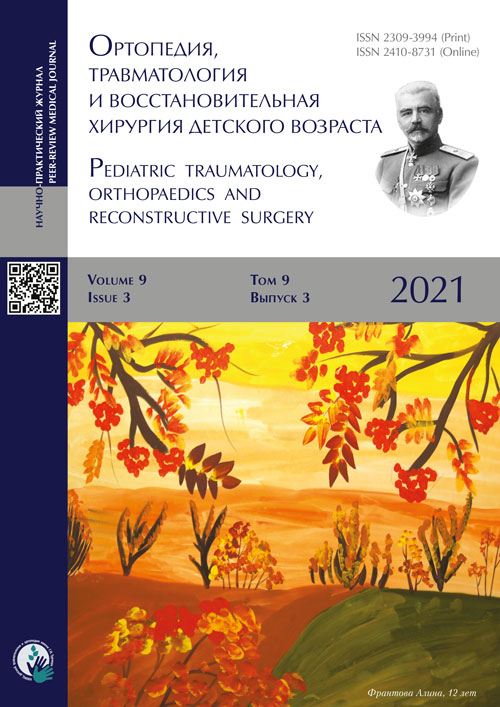FBN1基因突变引起的罕见的肢端骨骼发育不良变异的临床和遗传特征
- 作者: Markova T.V.1, Kenis V.M.2, Melchenko E.V.2, Nagornova T.S.1, Murtazina A.F.1, Dadali E.L.1
-
隶属关系:
- Research Centre for Medical Genetics
- H. Turner National Medical Research Centre for Children’s Orthopedics and Trauma Surgery
- 期: 卷 9, 编号 3 (2021)
- 页面: 327-337
- 栏目: Clinical cases
- ##submission.dateSubmitted##: 25.04.2021
- ##submission.dateAccepted##: 12.07.2021
- ##submission.datePublished##: 04.10.2021
- URL: https://journals.eco-vector.com/turner/article/view/65367
- DOI: https://doi.org/10.17816/PTORS65367
- ID: 65367
如何引用文章
详细
论证。地球物理发育不良和肩关节发育不良是罕见的遗传性疾病,其特征是侏儒症和骨骼结构发育不良。在国外文献中,仅描述了少数由FBN1基因突变引起的血液学和肢端发育不良的病例,而在国内文献中我们还没有遇到对此类患者的临床和遗传特征的描述。
临床观察。描述了三名由FBN1基因中的三种错义突变引起的肢端发育不良的女性患者的临床和遗传特征。2例患者根据临床表现和X线检查资料诊断为肢端发育不良,1例患者诊断为血液物理发育不良。所有鉴定的突变都位于FBN1基因的外显子中,该基因编码第五结构域的氨基酸序列,与转化生长因子-β具有同源性。
讨论。对临床和遗传相关性的分析使得之前陈述的关于在具有c.5206T>C突变的患者中发生严重的血液物理发育不良表型的假设成为可能,导致在1736位用精氨酸替换半胱氨酸c.5284G>A (p.Gly1762Ser)。我们发现的先前未描述的置换c.5177G>A (p.Gly1726Asp) 以及该密码子中的另一个先前描述的突变,导致谷氨酰胺被缬氨酸取代,导致不那么明显的肩峰发育不良表型。
结论。根据对三名俄罗斯患者的检查结果以及对文献中描述的患者的临床和遗传特征的分析,发现导致肢端发育不良的FBN1基因突变,包括太阳物理和肢端发育不良发育不良,破坏类似于第五转化生长因子的氨基酸序列。1型原纤维蛋白的β结构域。最严重的临床表现见于突变导致多肽链第 1736位精氨酸被胱氨酸取代,从而导致转化生长因子-β信号通路功能中断的患者。
全文:
作者简介
Tatyana Markova
Research Centre for Medical Genetics
编辑信件的主要联系方式.
Email: markova@med-gen.ru
ORCID iD: 0000-0002-2672-6294
SPIN 代码: 4707-9184
MD, PhD
俄罗斯联邦, Moskvorechye str., Moscow, 115522Vladimir Kenis
H. Turner National Medical Research Centre for Children’s Orthopedics and Trauma Surgery
Email: kenis@mail.ru
ORCID iD: 0000-0002-7651-8485
SPIN 代码: 5597-8832
http://www.rosturner.ru/kl4.htm
MD, PhD, D.Sc.
俄罗斯联邦, Saint PetersburgEvgenii Melchenko
H. Turner National Medical Research Centre for Children’s Orthopedics and Trauma Surgery
Email: emelchenko@gmail.com
ORCID iD: 0000-0003-1139-5573
SPIN 代码: 1552-8550
MD, PhD
俄罗斯联邦, Saint PetersburgTatyana Nagornova
Research Centre for Medical Genetics
Email: t.korotkaya90@gmail.com
ORCID iD: 0000-0003-4527-4518
MD, clinical geneticist
俄罗斯联邦, 1 Moskvorechye str., Moscow, 115522Aysylu Murtazina
Research Centre for Medical Genetics
Email: aysylumurtazina@gmail.com
ORCID iD: 0000-0001-7023-7378
SPIN 代码: 9807-3783
MD, neurologist, doctor of functional diagnostics
俄罗斯联邦, 1 Moskvorechye str., Moscow, 115522Elena Dadali
Research Centre for Medical Genetics
Email: genclinic@yandex.ru
ORCID iD: 0000-0001-5602-2805
SPIN 代码: 3747-7880
MD, PhD, D.Sc., Professor
俄罗斯联邦, Moskvorechye str., Moscow, 115522参考
- Le Goff C, Mahaut C, Wang LW, et al. Mutations in the TGFbeta binding-protein-like domain 5 of FBN1 are responsible for acromicric and geleophysic dysplasias. Am J Hum Genet. 2011;89:7–14. doi: 10.1016/j.ajhg.2011.05.012
- Spranger JW, Brill P, Hall C, et al. Bone dysplasias: an atlas of genetic disorders of skeletal development. 4th ed. USA: Oxford University Press; 2018. doi: 10.1093/med/9780190626655.001.0001
- Spranger JW, Gilbert EF, Tuffli GA, et al. Geleophysic dwarfismea “focal” mucopolysaccharidosis? Lancet. 1971;2:97–98. doi: 10.1016/s0140-6736(71)92073-3
- Maroteaux P, Stanescu R, Stanescu V, et al. Acromicric dysplasia. Am J Med Genet. 1986;24:447–459. doi: 10.1002/ajmg.1320240307
- Scott A, Yeung S, Dickinson DF, et al. Natural history of cardiac involvement in geleophysic dysplasia. Am J Med Genet A. 2005;132A:320–323. doi: 10.1002/ajmg.a.30450
- Faivre L, Le Merrer M, Baumann C, et al. Acromicric dysplasia: long term outcome and evidence of autosomal dominant inheritance. J Med Genet. 2001;38:745–749. doi: 10.1136/jmg.38.11.745
- Marzin P, Cormier-Daire V. Geleophysic dysplasia. In: Adam MP, Ardinger HH, Pagon RA, et al., editors. GeneReviews®. Seattle: University of Washington; 1993. [cited 4 December 2018]. Available from: http://www.ncbi.nlm.nih.gov/books/NBK11168/
- Richards S, Aziz N, Bale S, et al. Standards and guidelines for the interpretation of sequence variants: A joint consensus recommendation of the American College of Medical Genetics and Genomics and the Association for Molecular Pathology. Genet Med. 2015;17(5):405–424. doi: 10.1038/gim.2015.30
- Mortier GR, Cohn DH, Cormier-Daire V, et al. Nosology and classification of genetic skeletal disorders: 2019 revision. Am J Med Genet A. 2019;179(12):2393–2419. doi: 10.1002/ajmg.a.61366
- Lipson AH, Kan AE, Kozlowski K, et al. Geleophysic dysplasia–acromicric dysplasia with evidence of glycoprotein storage. Am J Med Genet Suppl. 1987;3:181–189. doi: 10.1002/ajmg.1320280522
- Wraith JE, Bankier A, Chow CW, et al. Geleophysic dysplasia. Am J Med Genet. 1990;35(2):153–156. doi: 10.1002/ajmg.1320350202
- Shohat M, Gruber HE, Pagon RA, et al. Geleophysic dysplasia: a storage disorder affecting the skin, bone, liver, heart, and trachea. J Pediatr. 1990;117(2 Pt 1):227–232. doi: 10.1016/s0022-3476(05)80534-7
- Marzin P, Thierry B, Dancasius A, et al. Geleophysic and acromicric dysplasias: natural history, genotype–phenotype correlations, and management guidelines from 38 cases. Genet Med. 2021;23(2):331–340. doi: 10.1038/s41436-020-00994-x
- Klein C, Le Goff C, Topouchian V, et al. Orthopedics management of acromicric dysplasia: follow up of nine patients. Am J Med Genet. 2014;164A(2):331–337. doi: 10.1002/ajmg.a.36139
- Stenson PD, Ball EV, Mort M, et al. Human gene mutation database (HGMD). Hum Mutat. 2003;21(6):577–581. doi: 10.1002/humu.10212
- Godwin ARF, Singh M, Lockhart-Cairns MP, et al. The role of fibrillin and microfibril binding proteins in elastin and elastic fibre assembly. Matrix Biol. 2019;84:17–30. doi: 10.1016/j.matbio.2019.06.006
- Sun C, Xu D, Pei Z, et al. Separation in genetic pathogenesis of mutations in FBN1-TB5 region between autosomal dominant acromelic dysplasia and Marfan syndrome. Birth Defects Res. 2020;112(20):1834–1842. doi: 10.1002/bdr2.1814
- Jensen SA, Iqbal S, Bulsiewicz A, et al. A microfibril assembly assay identifies different mechanisms of dominance underlying Marfan syndrome, stiff skin syndrome and acromelic dysplasias. Hum Mol Genet. 2015;24(15):4454–4463. doi: 10.1093/hmg/ddv181
- Hasegawa K, Numakura C, Tanaka H, et al. Three cases of Japanese acromicric/geleophysic dysplasia with FBN1 mutations: a comparison of clinical and radiological features. J Pediatr Endocrinol Metab. 2017;30(1):117–121. doi: 10.1515/jpem-2016-0258
- Cheng SW, Luk HM, Chu YWY, et al. A report of three families with FBN1-related acromelic dysplasias and review of literature for genotype-phenotype correlation in geleophysic dysplasia. Eur J Med Genet. 2018;61(4):219–224. doi: 10.1016/j.ejmg.2017.11.018
- Maddirevula S, Alsahli S, Alhabeeb L, et al. Expanding the phenome and variome of skeletal dysplasia. Genet Med. 2018;20(12):1609–1616. doi: 10.1038/gim.2018.50
- Moey LH, Flaherty M, Zankl A. Optic disc swelling in acromicric and geleophysic dysplasia. Am J Med Genet A. 2019;179(9): 1898–1901. doi: 10.1002/ajmg.a.61268
补充文件











